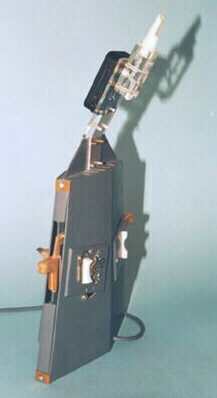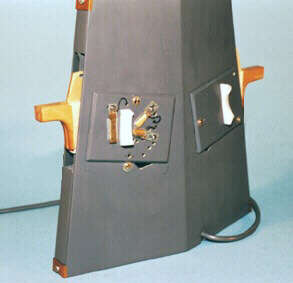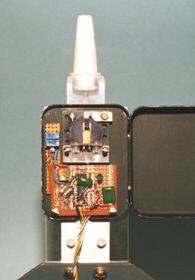The Stealth Up Close
 This photo shows my controller from the front. Starting from the top, the white piece is the mouthpiece "beak", the black rectangular object is a metal box containing the mouthpiece electronics and the big grey part is the main body.
This photo shows my controller from the front. Starting from the top, the white piece is the mouthpiece "beak", the black rectangular object is a metal box containing the mouthpiece electronics and the big grey part is the main body.The L-shaped wooden pieces sticking out the sides are the support ears. These hook over the vees between the thumb and first finger of each hand. The positions of the ears are adjustable to allow different amounts of finger curvature. Also seen on the sides (at the body corners) are two of the four spring clips that hold the body sections together. These just slide off to allow access to the inside.
The touch-sensitive keyworks are mounted on the two five-sided plates attached to the top of the body. This modular construction allows the entire subassembly to be removed, so that different keyworks (e. g., for different fingering systems, or for improved designs) can be substituted without altering the main body.
The touch-pad keys are made from strips of copper-clad PC board, with the copper peeled off except for square pads at the ends. Some of the keys are raised by brass blocks soldered onto the copper, the others have raised shoulders around their perimeters. The strips have slotted mounting holes, allowing them to be pivoted and slid, so the keys lie under the natural position of the fingers. The present keywork system has 17 keys: a main key for each of the first three fingers, three keys for each pinky, two "side keys" for the right-hand index finger, and three octave keys operated by the left thumb.
In addition to the keyworks, a touch-sensitivepressure plate is mounted on the left-hand subassembly. The left-hand index finger operates this plate by rotating towards the player.
 Here's a shot taken from near the side, which gives a fuller view of the mouthpiece construction. The beak section is machined from Delrin and is press fit into a clear plexiglass block. This block has a series of holes bored to lead the breath flow through the block and out a nozzle, also machined from Delrin and pressed into the block. A vertical passage leads the breath pressure into the pressure transducer, located inside the black box.
Here's a shot taken from near the side, which gives a fuller view of the mouthpiece construction. The beak section is machined from Delrin and is press fit into a clear plexiglass block. This block has a series of holes bored to lead the breath flow through the block and out a nozzle, also machined from Delrin and pressed into the block. A vertical passage leads the breath pressure into the pressure transducer, located inside the black box.Not visible is a second constriction, which is machined into a plastic rod pressed into the passage through beak. This constriction, in conjunction with the exit nozzle, regulates the flow of breath through the mouthpiece, as well as the pressure at the transducer.
Also seen in this photo are the two subassemblies for whatever thumb keys and/or transducers are being used, and a bent aluminum bracket connecting the mouthpiece assembly to the main body. The overall length of the instrument is 19".
 Here's a closer view of the thumb supports and the octave keys (which are operated by the left thumb). The thumbs have fixed rests -- the two white Delrin pieces -- which help support and balance the instrument while also keeping the hands oriented in a fixed position, which is important when using touch sensitive keys. The right-hand thumb is not presently being used.
Here's a closer view of the thumb supports and the octave keys (which are operated by the left thumb). The thumbs have fixed rests -- the two white Delrin pieces -- which help support and balance the instrument while also keeping the hands oriented in a fixed position, which is important when using touch sensitive keys. The right-hand thumb is not presently being used.Getting the octave keys comfortable was challenging, as can be seen by the large number of extra holes (aka, mistakes). The thumb contacts the three brass touch-keys by rocking. Rocking back contacts the -1 octave key (to the left in the photo), rocking forward contacts first the +1 octave key and rocking forward and rolling upward contacts the +2 octave key. The +2 octave key has precedence over the +1 octave key, so it can be touched alone or at the same time as the +1 octave key. As presently configured, the total instrument range is four octaves.
 This photo shows the inside of the instrument. The body is in three pieces: a central plate with a cutout for the 4.5" x 8" circuit board, plus top and bottom covers that clip into place. The construction is a wooden buildup using thin aircraft plywood with basswood reinforcement strips on the inside and fiberglass-epoxy lamination on the outside. The cross section of the body is roughly diamond shaped, about 2" tall and 7" wide at the mouthpiece end and about 3" x 10" at the base.
This photo shows the inside of the instrument. The body is in three pieces: a central plate with a cutout for the 4.5" x 8" circuit board, plus top and bottom covers that clip into place. The construction is a wooden buildup using thin aircraft plywood with basswood reinforcement strips on the inside and fiberglass-epoxy lamination on the outside. The cross section of the body is roughly diamond shaped, about 2" tall and 7" wide at the mouthpiece end and about 3" x 10" at the base. The final picture shows the inside of the box that houses the mouthpiece electronics and the pressure transducer. The dark blue circle near the top of the box is a rubber diaphragm that moves in response to the breath pressure. Riding atop the diaphragm is a spring-loaded metal foot (silver and grey in the photo -- the spring stems from the piece of metal along the top right-hand side of the assembly). A flag (or vane) on top of the foot rides up and down across the path of an opto-isolator device, which is inside the small yellow brass housing above the diaphragm. Total motion of this sensor system is about 1 mm, providing a response time of just a few milliseconds.
The final picture shows the inside of the box that houses the mouthpiece electronics and the pressure transducer. The dark blue circle near the top of the box is a rubber diaphragm that moves in response to the breath pressure. Riding atop the diaphragm is a spring-loaded metal foot (silver and grey in the photo -- the spring stems from the piece of metal along the top right-hand side of the assembly). A flag (or vane) on top of the foot rides up and down across the path of an opto-isolator device, which is inside the small yellow brass housing above the diaphragm. Total motion of this sensor system is about 1 mm, providing a response time of just a few milliseconds.Back Home